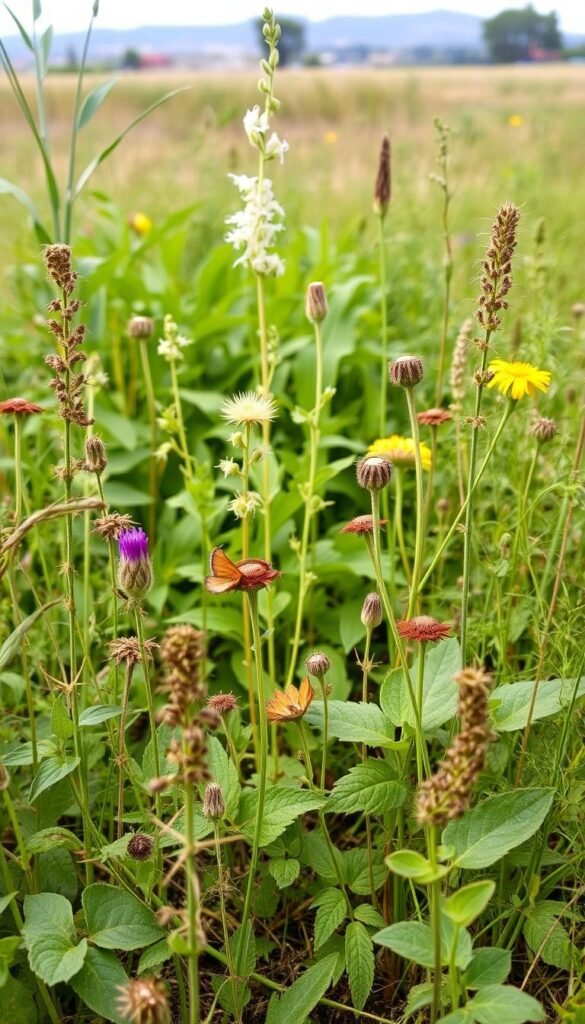Have you ever wondered why certain plants pop up where you didn’t plant them? These uninvited guests—often called weeds—are simply nature’s way of filling empty spaces. While some can harm your garden or local ecosystems, others play surprising roles in soil health and biodiversity.
Many new growers feel frustrated when unfamiliar leaves crowd their flowerbeds. The secret lies in knowing which plants to remove and which might actually help your green space thrive. You’ll soon realize that spotting these invaders early makes all the difference in maintaining a healthy landscape.
Government agencies classify certain species as noxious due to their harmful impacts. Others earn the “invasive” label when they outcompete native plants. But here’s the twist: some weeds you’re pulling might be providing free pest control or erosion prevention!
This resource simplifies plant recognition through practical observation techniques. You’ll learn to distinguish between temporary nuisances and serious threats before they spread seeds or develop stubborn roots. With clear visual guides and pattern recognition tips, managing your outdoor areas becomes less guesswork and more strategy.
Mastering these skills transforms gardening from a battle against nature into a collaborative dance. Soon, you’ll spot familiar leaf shapes and growth patterns like a pro, saving time and energy for the plants you truly want to nurture.
Understanding Garden Weeds: Definitions and Importance
What if your garden’s uninvited greenery held hidden value? The term “weed” describes any plant growing where it’s not wanted – a definition that changes based on your location and goals. While some species damage ecosystems, others quietly support your soil’s health.
What Makes a Plant a Weed?
Context shapes weed identification. Goldenrod might beautify a meadow but choke vegetable beds. Government agencies label plants as noxious weeds when they threaten agriculture or native habitats. As one botanist notes:
“A rose in a wheat field becomes a weed – it’s all about perspective.”
Three main categories matter most:
| Type | Traits | Management Priority |
|---|---|---|
| Noxious | Legally regulated threats | Immediate removal |
| Invasive | Non-native spreaders | Prevent expansion |
| Beneficial | Soil improvers | Selective tolerance |
The Role of Weeds in Your Garden Ecosystem
Many plants we call weeds serve nature’s purposes. Dandelions aerate compacted earth, while clover adds nitrogen to soil. Annual weeds like chickweed often indicate rich nutrients, while perennials like thistle suggest poor drainage.
Before removing unwanted plants, consider their hidden benefits. Some provide early spring pollen for bees, while others prevent erosion on bare slopes. Your approach should balance control with ecological awareness – not all green intruders require warfare.
Recognizing the Common Traits of Garden Weeds
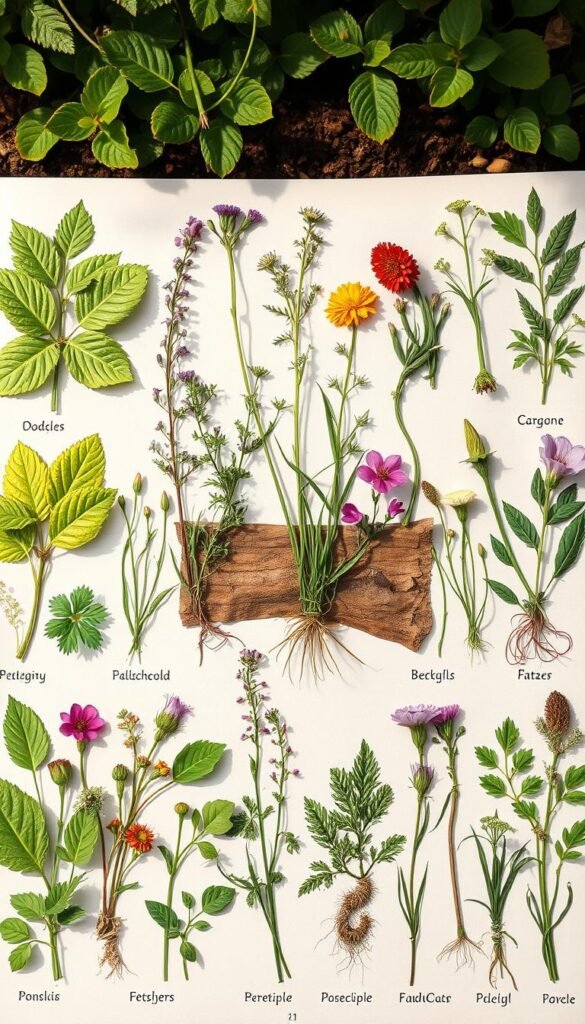
Ever noticed how some plants sneak into your garden uninvited? Their survival strategies reveal patterns you can use to outsmart them. By decoding leaf shapes, root behaviors, and spreading tactics, you’ll turn random greenery into identifiable opponents.
Identifying Leaves, Roots, and Flowers
Leaves often betray a plant’s identity first. Look for triangular forms (like plantain), jagged edges (resembling dandelions), or waxy surfaces. Opposite or alternating leaf arrangements offer more clues than you might expect.
Dig deeper—literally—to understand root systems. Dandelions anchor with stubborn taproots, while quackgrass spreads through rhizomes. These underground networks determine whether you’ll need a trowel or a systemic herbicide.
When flowers appear, note their color clusters and bloom shapes. Yellow hawkweed forms flat-topped clusters, while creeping Charlie sports tiny purple blossoms. Seasonal timing matters too—early bloomers often spread seeds before summer heat.
How Weeds Spread in Your Lawn and Landscape
Your lawn becomes a battleground through two main invasion routes. Wind-blown seeds parachute into bare spots, while underground runners colonize new territories. Crabgrass uses both strategies, making it a persistent foe.
Watch for these spreading tactics:
- Stolons (above-ground stems) creeping across soil surfaces
- Rhizomes tunneling beneath mulch beds
- Root fragments regenerating after incomplete removal
Understanding these methods helps you disrupt their life cycles. For example, mowing before seed formation stops annual invaders, while smothering techniques block light-dependent sprouters. Explore common weed types to recognize which strategies your green intruders use.
Spotting Key Weed Characteristics in Your Backyard
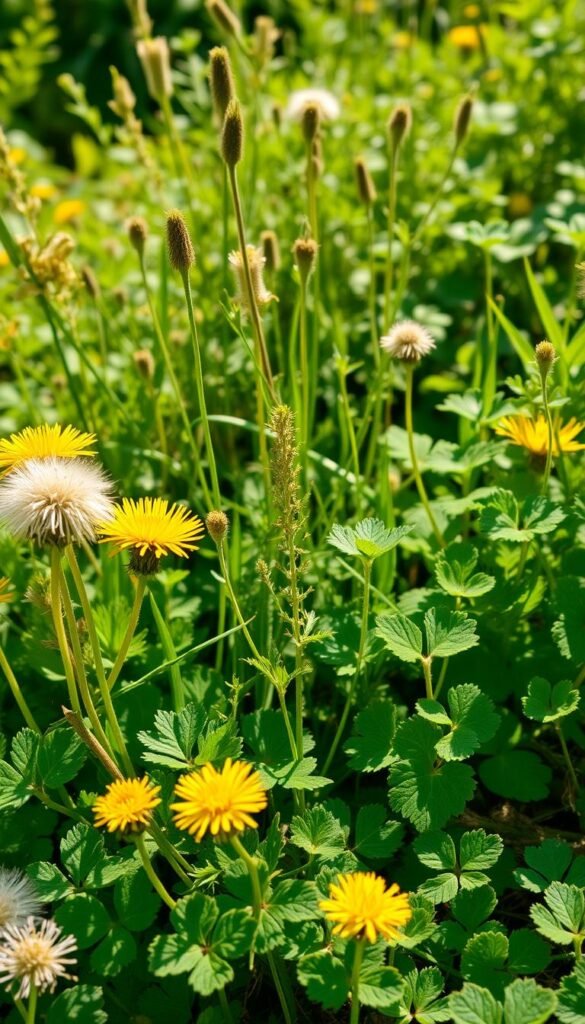
Notice odd patterns in your yard that don’t match your planted greenery? Those irregularities often signal uninvited guests. Sharpening your observation skills helps separate temporary visitors from persistent invaders before they establish strongholds.
Visual Cues to Look For
Start with leaf shapes – heart-shaped wild violets or arrowhead-like smartweed stand out among rounded garden plants. Look for scalloped edges on dandelions or jagged teeth on thistle leaves. These features act like nature’s name tags.
Growth patterns reveal hidden strategies. Some weeds form flat rosettes to hug the ground, while others climb vertically to steal sunlight. Creeping Charlie sends out runners that carpet your lawn, unlike clover’s compact clusters.
Stem textures offer tactile clues. Rub a stem between your fingers – square stalks signal mint relatives, while triangular ones indicate sedges. Hairy stems often belong to ragweed or nettles, unlike smooth garden specimens.
Watch for color shifts in your yard. Lamb’s-quarters show silvery undersides, while pokeweed stems turn magenta. These flashes of contrast help spot troublemakers before they flower or drop seeds.
Seasonal changes matter too. Spring brings chickweed’s star-shaped blooms, while summer heat triggers purslane’s fleshy growth. Recognizing these cycles helps you time removals effectively, preserving your favorite plants.
The Role of Soil and Climate in Weed Growth

Did you know your garden’s soil acts like a bouncer deciding which weeds get in? Earth composition and weather patterns create invisible filters that determine which unwanted plants thrive. By reading these natural cues, you can predict and prevent invasions before they start.
Soil Health and Water Availability
Compacted ground becomes crabgrass paradise, while chickweed claims nitrogen-rich patches. Your dirt’s texture and nutrients directly influence which invaders appear. Sandy soils with quick drainage attract drought-loving purslane, whereas moist clay welcomes moisture-hungry nutsedge.
| Weed Type | Preferred Soil | Moisture Needs | Active Season |
|---|---|---|---|
| Crabgrass | Compact, poor | Low | Summer |
| Chickweed | Rich, neutral pH | High | Spring |
| Purslane | Sandy, dry | Minimal | Summer |
| Creeping Charlie | Damp, shaded | Moderate | Spring-Fall |
Boost your defenses by amending earth structure. Adding compost breaks up hardpan areas, while proper drainage drowns out water-loving intruders. A simple pH test reveals why certain weeds dominate your space.
Impact of Sunlight and Temperature
Sun exposure dictates weed shifts through the year. Shade-tolerant species vanish when you prune tree branches, while full-sun invaders retreat under strategic plantings. Temperature changes trigger growth spurts – chickweed germinates in cool spring soil, while crabgrass waits for summer heat.
Time your counterattacks using seasonal patterns. Apply pre-emergent treatments before expected germination periods. Mulch bare spots during peak growing seasons to block light-dependent seedlings. Your garden’s microclimate holds the key to lasting weed control.
Beginner’s Guide to Identifying Common Garden Weeds
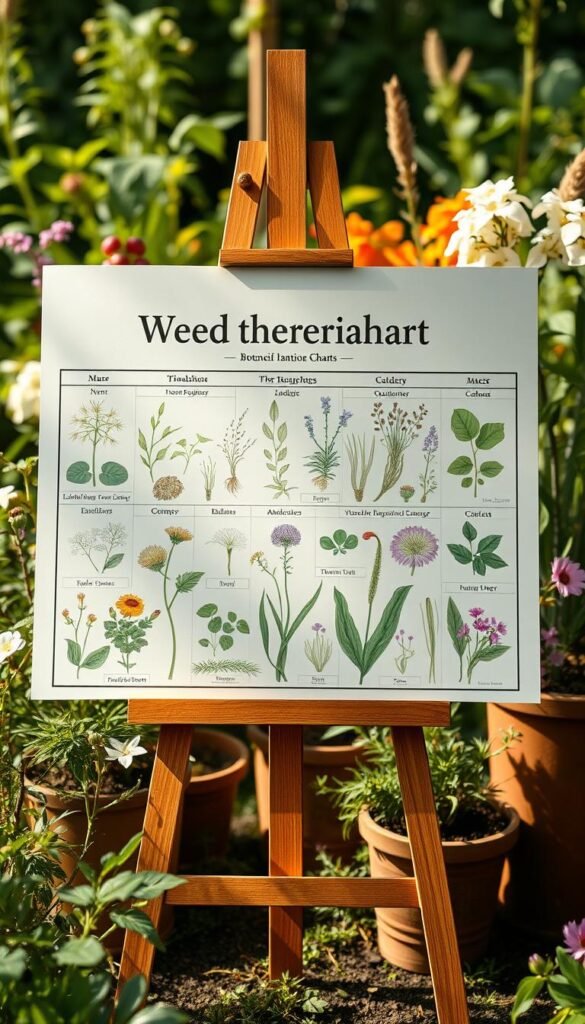
Spotting unwanted greenery becomes simpler when you focus on frequent offenders. Four troublemakers dominate most landscapes: crabgrass, dandelions, chickweed, and purslane. Each leaves unique signatures that help you take charge of your space.
| Weed | Type | Key Features | Control Window |
|---|---|---|---|
| Crabgrass | Grassy annual | Finger-like seed heads, spreads outward | Pre-emergent spring |
| Dandelion | Broadleaf perennial | Yellow flowers, taproot | Fall herbicide |
| Chickweed | Low-growing annual | Tiny white blooms, oval leaves | Early spring removal |
| Purslane | Succulent annual | Fleshy stems, yellow flowers | Summer cultivation |
Categorize invaders by growth style. Grassy types mimic lawn blades, while broadleaf varieties show wider foliage. Sedges stand out with triangular stems – twist one between your fingers to confirm.
Focus on unchanging traits for reliable ID. Check if leaves grow opposite each other or alternate along stems. Dig gently to inspect roots – fibrous networks suggest annuals, while thick taproots signal perennials.
Time your inspections wisely. Catch crabgrass as seedlings before they form crab-like legs. Remove dandelions when their first yellow petals appear. These windows prevent seed spread and save future effort.
Boost your success by distinguishing short-lived annuals from recurring perennials. Quick action stops crabgrass in one season, while dandelions need persistent control. Pair these tips with regular patrols to maintain your garden’s balance.
Identifying Specific Weeds: From Creeping Charlie to Dandelions
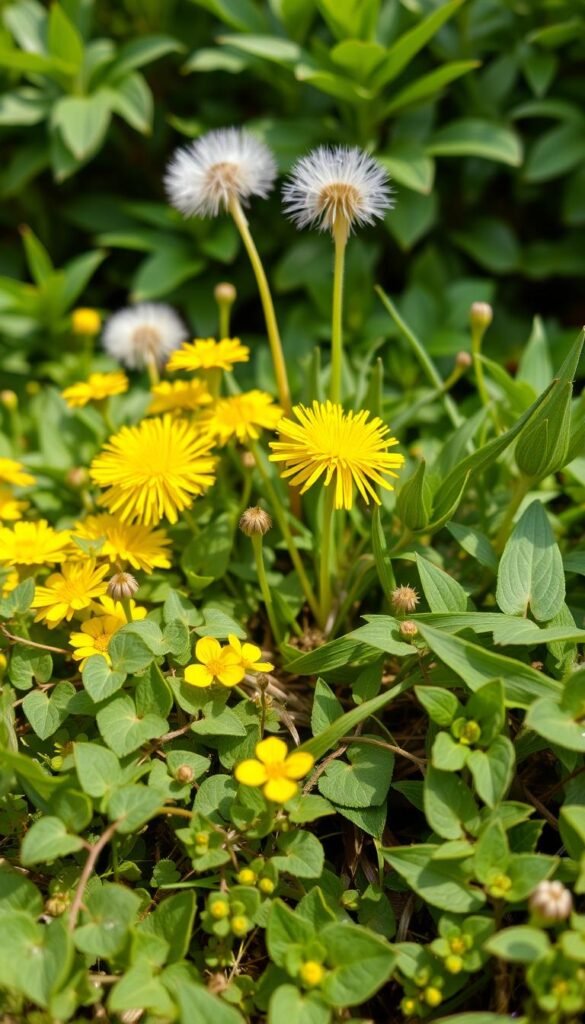
Ever found mysterious plants taking over your flowerbeds? Three frequent offenders leave unique markers in your landscape. Learning their signatures helps you act before they dominate your space.
Recognizing Creeping Charlie and Ground Ivy
Creeping Charlie, sometimes called ground ivy, announces itself with round, scalloped leaves that smell minty when crushed. Its stems crawl across soil, forming dense mats in shady spots. Look for clusters of small purple flowers in late spring – a surefire identifier.
Spotting Common Weeds Like Dandelions and Bindweed
Dandelions show tooth-edged leaves radiating from a central point, with bright yellow blooms turning into fluffy seed heads. Their taproots snap easily, so dig deep when removing. Bindweed reveals itself through arrowhead-shaped leaves on climbing vines, sporting pale pink trumpet-shaped flowers that hide its aggressive nature.
| Weed | Key Features | Growth Pattern | Weakness |
|---|---|---|---|
| Creeping Charlie | Mint-scented leaves, purple blooms | Spreads via surface runners | Shallow rhizomes |
| Dandelion | Yellow flowers, deep taproot | Basal rosette | Vulnerable in fall |
| Bindweed | Twining vines, morning glory blooms | Underground runners | Light deprivation |
Notice how each plant’s survival strategy becomes its downfall. Charlie’s fragrant leaves help you spot it early, while dandelion’s showy flowers signal prime removal time. Bindweed’s attractive blooms distract from its choking roots – pull vines before they strangle nearby plants.
Effective Weeding Techniques for New Gardeners
Knowing when and how to remove unwanted plants preserves your garden’s health while saving effort. Timing your approach based on soil conditions and weed types makes the difference between temporary fixes and lasting control.
Hand-Pulling and Digging Methods
Wait until the soil feels damp—like after rain—to tackle weeds by hand. Grip stems close to the ground to avoid snapping them, which leaves stubborn roots behind. Shallow digging prevents buried seeds from surfacing, stopping future invasions before they start.
When to Use a Hoe or Trowel
Reach for a hoe when dealing with young, shallow-rooted invaders in open spaces. Its sweeping motion clears large areas quickly. A trowel works better for precise removal of deep-rooted offenders like dandelions, letting you extract the entire taproot with minimal soil disruption.
Pair these methods with regular checks to catch sprouts early. Your garden thrives when you match tools to the task—hoes for prevention, trowels for precision, and your hands for timely interventions.

